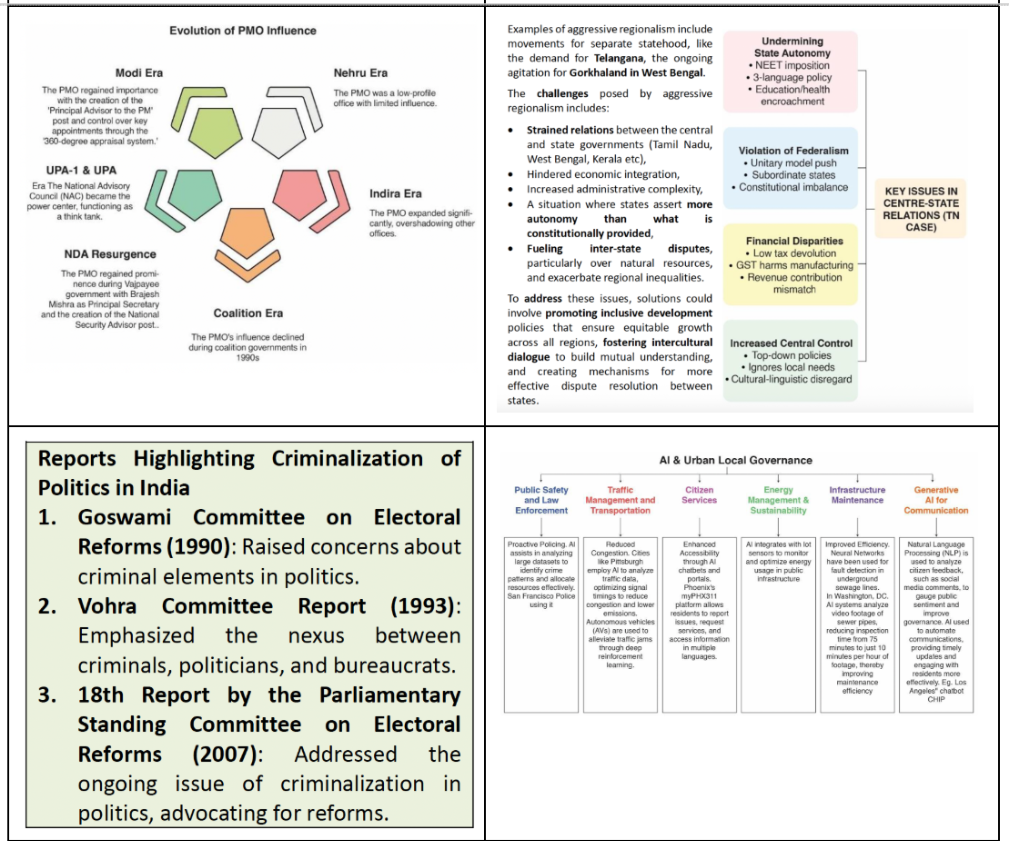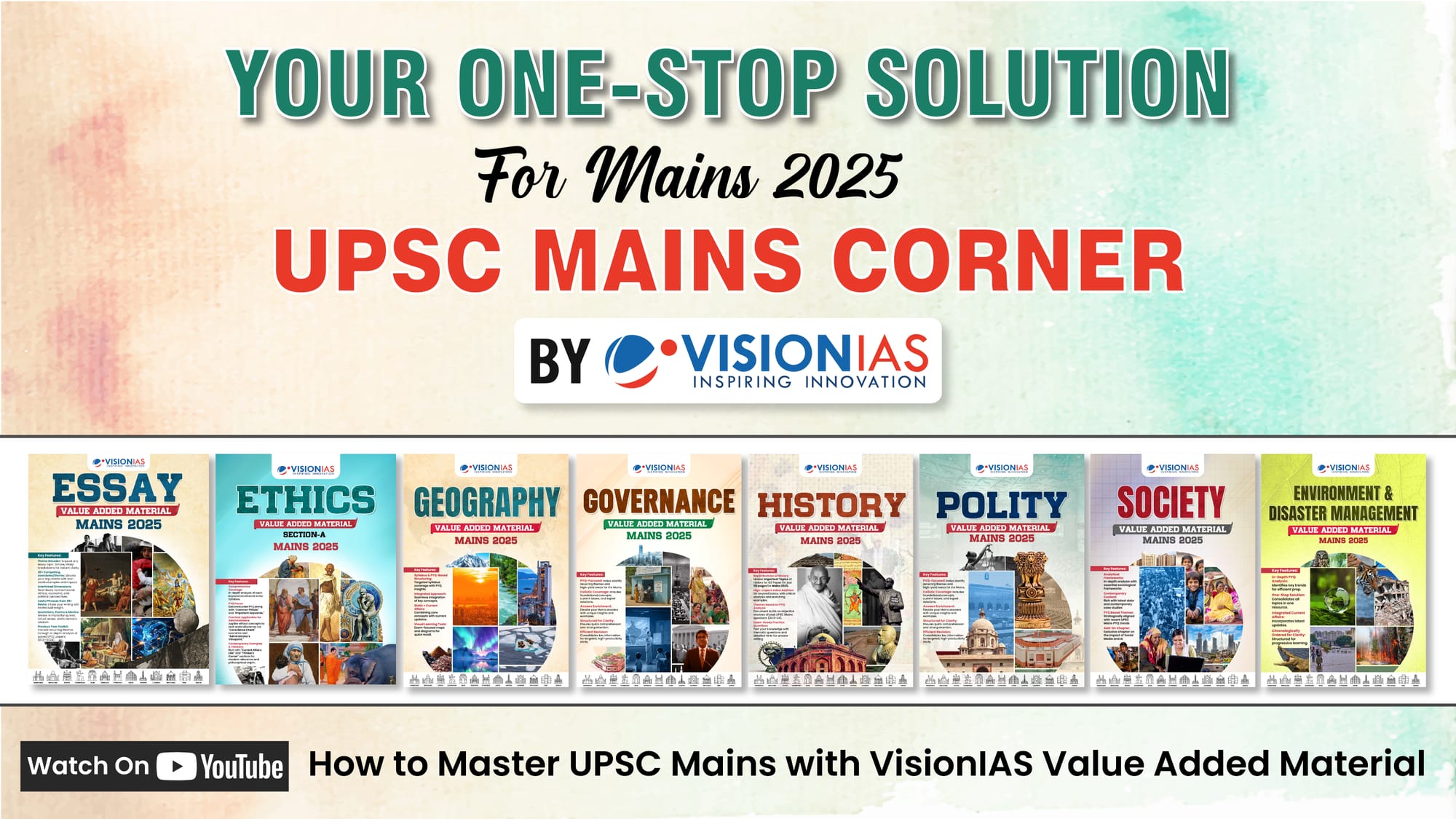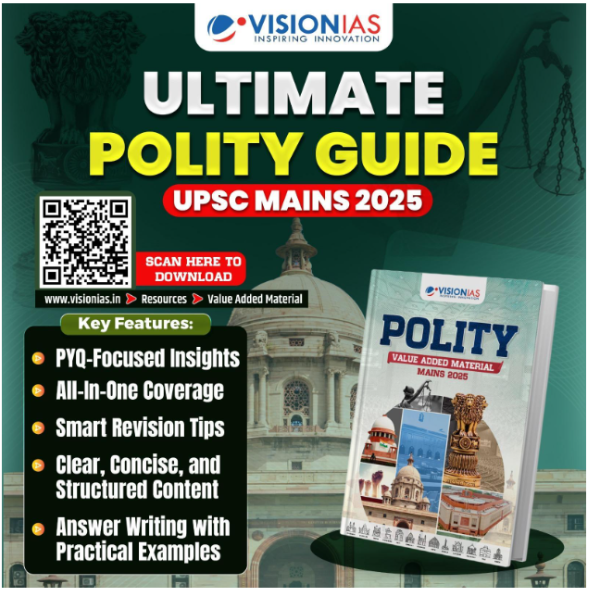Coverage of UPSC Mains 2025 syllabus is quite challenging for aspirants after UPSC Prelims 2025. Aspirants has to cover updated content for the exam in very short period of time. In this challenging times VisionIAS Value added Material (VAM) provide a unique opportunity to cover UPSC Mains syllabus throughly.
As Sun Tzu wisely stated, "If you know the terrain and know yourself, you need not fear the result of a hundred endeavors." This profound wisdom is very relevant for every aspirant preparing for the UPSC Civil Services Mains Examination.
The "terrain" here represents the complex landscape of UPSC Mains 2025. The period between Prelims and Mains is precisely when you must "know yourself" by assessing your preparation, balancing UPSC optional and "know the terrain" by understanding the exam's true demands. Having the right resources is crucial for navigating this challenging endeavor.
High Weightage of Polity in UPSC Mains
Polity section of GS Paper 2 is paramount in UPSC Mains. It consistently holds the highest weightage. The sectional weightage of the Polity syllabus for UPSC was around 49 percent (2013-24 period) of the GS. This significant share demands special focus for high scores in the Mains exam.

The Evolving Landscape of UPSC Mains Polity Paper
The UPSC Mains Polity paper is peculiar. Students often start preparation here, yet feel unprepared for Mains. This stage demands application, analysis, and critical evaluation, unlike Prelims.
The paper's landscape has shifted significantly. It now demands a revamped strategy and updated sources. We observe more questions on the Constitution's philosophical dimensions. Concepts like 'Constitutional Morality' and 'Constitutionalism' are central. Questions based on important judgments are prevalent. They require connecting legal pronouncements with broader implications.
Federal relations are also a heightened focus. This includes Centre-State and inter-state issues (e.g., natural resources, finances, constitutional functionaries). Traditional sources often do not reflect these nuances.
Common Pitfalls in UPSC Main Polity Preparation
Aspirants preparing for UPSC Mains 2025 Polity face several common challenges:
- Fragmented & Outdated Resources: Many rely on different sources for static Polity content and current affairs. This fragmented approach hinders linking concepts. Relying on outdated material is also a common issue.
- Lack of Thematic Prioritization: Polity is not a monolithic subject. Students often fail to identify and prioritize topics. This prevents deeper focus on areas of higher relative importance.
- The Static-Theory Trap & Application Gap: Focusing only on static theory is common. Students struggle to apply concepts with recent examples or committee reports. This results in generic answers.
- Current Affairs Disconnect: Students not regularly reading newspapers panic about dynamic aspects. They scramble for current affairs material. This often comes at the expense of solidifying core static understanding.
Vision IAS Polity VAM: Your One-Stop Solution for UPSC Mains 2025
Recognizing these challenges, Vision IAS meticulously crafted its Polity (GS Paper 2) Value Added Material (VAM) for Mains 2025. It is an encompassing, one-stop solution. It addresses every student's need and bridges preparation gaps. This document is a strategic tool.

Here's how our Polity VAM empowers your Mains journey:
- PYQ-Driven Focus & Strategy: Our VAM is based on objective analysis of UPSC Mains Polity questions from 2013 to 2024. It includes a comprehensive macro-analysis of PYQs. Polity is not a monolithic subject. We have divided the syllabus into 14 different themes.
- Each theme's treatment is meticulously linked to past trends analysis. A micro-level PYQ analysis prefaces each theme. This guides your approach to maximize scores. Your preparation aligns precisely with UPSC's expectations.

- Tailored Thematic Approach: Examples of themes include Fundamental Rights, DPSPs, and Fundamental Duties. Union and State Legislature, and Constitutional Bodies are also key themes. Each theme receives a different, tailored approach as needed.
- Integrated Static-Dynamic Coverage: Our VAM briefly revises core constitutional concepts. It then delves into exam-relevant themes from both static and dynamic aspects. This provides a 360-degree holistic approach to every topic. You will be well-prepared for questions that connect static concepts with current events.
- Strategic Answer Enrichment: Elevate your Mains answers with unique insights and examples. Our curated content provides critical analysis, relevant committee recommendations, important judgments, and contemporary viewpoints. This helps you enrich your answers and stand out.
- Efficient & Targeted Revision: The VAM is structured for clarity. It ensures quick comprehension and strong retention. It consolidates key information for targeted, high-productivity study. Flowcharts and structured content facilitate efficient revision.
A Closer Look at Vision IAS Polity VAM


This meticulously prepared resource is designed to be your trusted companion. It provides the content and confidence to write high-scoring answers. It truly transforms hard work into success.
Trust the process. Utilize this material to its fullest potential. Walk into the examination hall with confidence. Prepare smartly.
Conquer UPSC Mains 2025 Polity with Vision IAS!

Watch: How to Master UPSC Mains with VisionIAS Value Added Material
Download the Polity (GS Paper 2) Value Added Material for Mains 2025 here
For comprehensive Mains preparation, explore our All India GS Mains PYQ-Plus Test Series 2025 and GS Mains Advanced Course 2025.

FAQs: VisionIAS Polity VAM for UPSC Mains 2025
Q1. Why is Polity considered a high-priority subject in UPSC Mains GS Paper 2?
Polity consistently holds the highest weightage in GS Paper 2. Between 2013 and 2024, it accounted for approximately 49 percent of the paper, making it a critical focus area for scoring well in Mains.
Q2. What are the common mistakes students make while preparing for Polity in UPSC Mains?
Common pitfalls include relying on fragmented and outdated resources, ignoring thematic prioritization, focusing solely on static theory without application, and a disconnect from current affairs.
Q3. How does VisionIAS Polity VAM help overcome these challenges?
VisionIAS Polity VAM bridges gaps with a structured thematic approach, PYQ-based analysis, integrated static-dynamic coverage, and answer enrichment through critical judgments, examples, and committee reports.
Q4. What makes the VisionIAS Polity VAM different from other study materials?
It is meticulously crafted based on trend analysis of UPSC questions, divided into 14 strategic themes, integrates current affairs, and focuses on exam-oriented content with structured revision tools like flowcharts.
Q5. Is VisionIAS Polity VAM suitable for use after UPSC Prelims 2025?
Yes, it is designed specifically for the post-Prelims to Mains phase. It provides focused, high-retention content ideal for quick and strategic preparation within the limited time window before Mains.